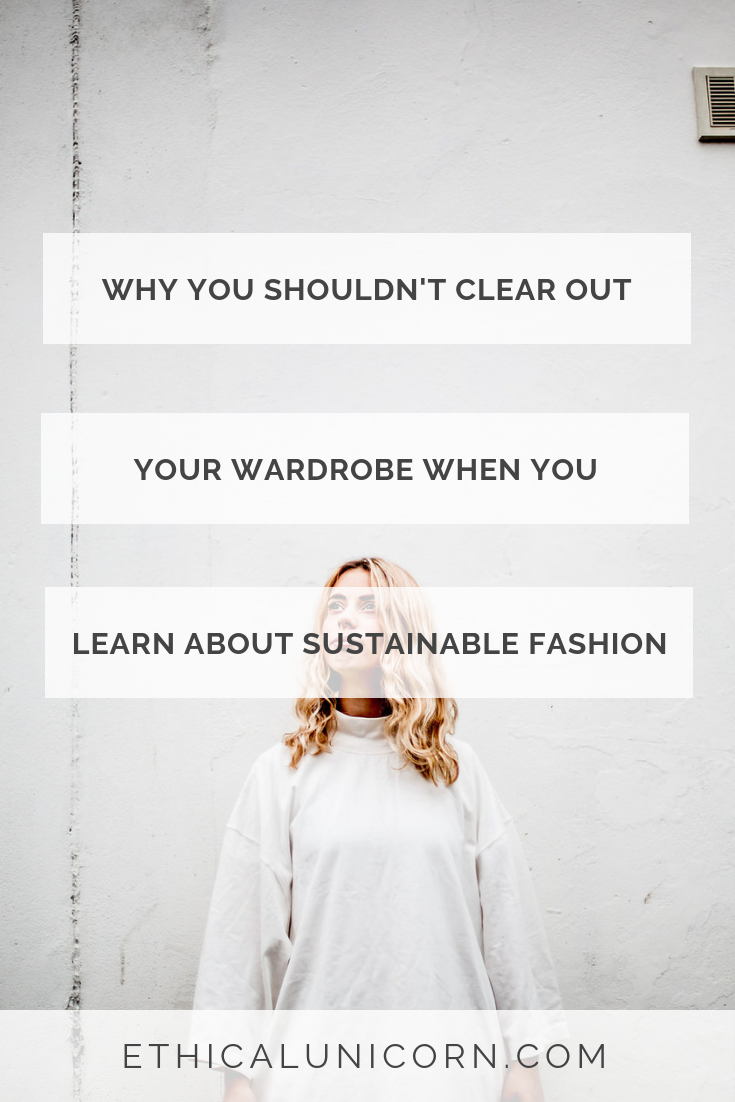Since the airing of Stacey Dooley’s BBC documentary on fast fashion and the environment a few weeks ago I’ve noticed both a rise in my readership (I’m guessing people have been searching how polluting the fashion industry is and coming across this blog post) and a rise in the amount of “mainstream” influencers talking about the downsides of the industry too.
This is definitely a good thing. These influencers reach many more people than I do currently, and if their recommendations or broaching of topics leads people to research and learn more about the ways we’re consuming and how detrimental that is to the world around us, then that is great. We gravely need these things to become more mainstream and permanently enter the national conversation, in fact we need them to be the norm.
But, in the wake of this increased conversation, I have noticed one trend that I believe comes from a good place, but is in fact the complete opposite of what we need as a first response to the hyper-consumerism problems we have right now.
So please, please, stop clearing out your wardrobe because you just learned about sustainable fashion.




I understand the urge to do this, it’s the exact same trend that occurred when people started watching the minimalists documentary. You suddenly feel inspired to live with less, so you want to go on a huge binge and become the ultra minimal, zen like creature you know has always been inside of you, just dying to get out. This totally comes from the right intentions but the thing is, it’s not actually the sustainable choice.
Here are some reasons why you should pause for a second before you actually go through with this plan of action, and some alternative options instead:
It’s disposability culture masquerading as sustainable
The most sustainable wardrobe is always a durable wardrobe. Because yes, fashion has its manufacturing issues, but those arose because retailers are desperate to cut costs in an attempt to make as much as possible for as low a cost as possible.
You know what drives that kind of action? Demand.
If you start chucking everything away in order to replace it with more ethical options, that’s still increasing the demand for more. If you transfer your fast fashion consumption rates over to secondhand stores only to get rid of those pieces after a few wears, that’s still sustaining a culture of overconsumption and disposability. Firstly, this isn’t going to make you happy. Secondly, this does nothing to combat the systemic problem we have when it comes to consumption.
I’m not saying never shop again. I’m not saying don’t treat yourself occasionally and never ever do a clear out of your things. But I do want to emphasise that climate disaster and human rights violations aren’t problems we can solve by buying more stuff. We have a huge trash problem, and constantly consuming and regularly throwing away is only going to make it worse. Especially seeing as most of our donated clothes won’t be bought by someone else, they’ll become another piece of waste. But more on that later.
Capsule wardrobes aren’t meant to be constantly overhauled
Honestly, I think there are some well meaning people out there who truly don’t quite understand what a capsule wardrobe is meant to be.
The term ‘capsule wardrobe’ was coined by a woman called Susie Faux in the 1970s, as a response to people spending too much on too many fashion items that were poorly made, didn’t fit, and wouldn’t be on trend for long. The capsule wardrobe was designed to be made up of essential, timeless items that were high quality and fit well, therefore lasting for years, that could be paired with small seasonal accents such as accessories. It streamlined the wardrobe and created a closet that could be endlessly mixed and matched, with the occasional addition of a high quality, more expensive piece that would end up as better value for money due to its longevity.
I actually wrote a post on this a while back, but I made a conscious decision not to have a capsule wardrobe. You know why? Because I haven’t grown in ten years, and I was regularly wearing just about everything in my closet. I’m quite firm with myself about rotating my clothes so they all get good wear, which meant that if I cleared out my wardrobe I would be needlessly getting rid of things I still wore in order to tick a ‘sustainable fashion’ box.
What I’m seeing now is influencers who, in a desire to be more sustainable, have gone for a capsule wardrobe. But then every time the seasons change they buy new pieces, and make content about what they’re getting rid of and replacing it with. For example every autumn brings new knitwear to add to the capsule wardrobe. Which just makes me wonder, what happened to the jumpers you bought last year? If they couldn’t last one season plus being in storage through the warm months, was that really a sustainable purchase? If you’re buying new pieces every time, especially when it comes to items that are meant to be staples that stick around, doesn’t that kind of defeat the point of a capsule wardrobe? In fact it seems like that’s what normal fashion bloggers do, but the capsule wardrobers also add getting rid of things to the mix too, in the name of ‘sustainability always looks like less’.
I mean hey, I’ve been guilty of getting three new jumpers this year. But guess what: I don’t have a capsule wardrobe and I do rotate them to make sure I wear them all. Plus, I keep them. I have jumpers that are literally over ten years old that still come out every winter, and they’re doing just fine.
So repeat after me: capsule wardrobes are not the only way to be sustainable. Capsule wardrobes work if you actually buy staples that you continue wearing year after year, with the occasional addition of a new piece or bringing in a replacement item when one you already have has truly reached the end of its life. If you’re just swapping out staples each year for newer ones, I’d say abandon the capsule idea over sending things to be wasted when they are still perfectly fine to wear.



Most donated clothes won’t be sold in your local charity shop, they will be wasted.
You might think that giving your old clothes to charity guarantees that they’ll go to a better home, that the charity will make money because of your kind donations, and that your pieces will live a long life for years to come in someone else’s closet. Nope.
In fact, only 10-20% of clothing that is donated to charity ends up getting sold in local shops. The rest is often sold to foreign buyers, who import and resell in their countries. If we’re taking the sustainability angle here, this is not the eco-friendly option, as your clothes are shipped halfway round the globe and cause some serious carbon emissions on the way. But beyond that, a lot of other countries don’t want our used clothes any more. That’s because we’re buying so much low quality fast fashion, which means the quality is literally too low to resell, and these items are classified as ‘junk’. And you know what they do with those clothes? They get incinerated.
So yeah, sure. If you donate something really amazing, like a designer or really high quality piece, it will probably be sold on in a charity shop and live a happy life in someone else’s wardrobe. But if you’re donating your high street purchases they’re probably going to be shipped abroad or burned, neither of which are great. Basically, regularly donating huge amounts of high street clothes after a few wears does almost nothing to help the environment.
What you can do instead
But don’t worry, it’s not all doom and gloom. If you didn’t know before don’t beat yourself up, because you know now and can make better choices. There are some alternative options that are better for the planet:
-
ROTATE YOUR CLOTHES
Firstly, stop needlessly throwing your stuff away just because you’ve learned that it’s not sustainable. It’s ok that you bought it from a fast fashion retailer. You own it now, it’s too late to change that. What matters now is how you look after what you have. Rotating your clothes is a really easy way to avoid over wearing and over washing, which will make your items last longer and be better quality. Also make sure you are looking after your clothes properly, and wash them in a microfibre catching bag to keep your plastic pollution down.
-
DON’T SHOP THE SEASONS
You really can’t shop the seasons any more because we now have over 52 of them a year, making it literally impossible to keep up. Topshop introduces 400 new styles per week, so you’re set up to fail there. Instead of constantly trying to keep on trend and inevitably falling behind, which can lead to buying and getting rid of things faster than you can blink, just take a minute to breathe. Instead, take some time to figure out your style and what you actually like, and use that to dictate how you shop and put together your wardrobe instead. Don’t worry, that doesn’t mean you have to go crazy minimal! I certainly haven’t, and in fact I’ve put together an entire guide on how to find a personal style that’s unique to you here.
This also doesn’t mean you can never engage with any trends again, I’m just saying don’t try to follow every single one. But if something pops up that you genuinely enjoy, that’s ok too! There are still healthier ways to engage with it. For example, rainbow print has been popping up quite a lot in recent months. As someone who really enjoys colour, I was quite excited that this was becoming a bit more common. But instead of going to fast fashion stores, I bought a vintage pair of rainbow trainers for £20 (these are still to be photographed but trust me, they will be). Even I, a sustainable blogger, can engage in the occasional trend now and again, (although it is quite rare for me because to be honest, I am too lazy to even research that kind of thing). It’s just about doing it in a healthy way, and when I do making sure it’s something that I would wear beyond one season. I’d been looking at these particular shoes for a year already before I bought them, and I will most likely wear them for at least ten years now I have them.


-
DON’T DONATE, SELL YOUR CLOTHES INSTEAD
It’s still ok to declutter now and then, but there are ways to do it that don’t involve donating. Charity shops are inundated with donations right now and a lot of it is not getting recycled, so why not try selling clothes yourself first?
You can do this with websites like Ebay or apps like Depop if you want to make a bit of money for yourself, or try Buengo if you still want that money to go to a good cause. If that’s too much hassle, try inviting your friends round for a clothes swap! I’ve done this before and it’s really fun to make a night of it, and a great excuse to have a good time together. You could also get a few friends together and host a clothes sale for charity which helps the world, helps the planet, and helps people shop secondhand.
In particular I’d love to see more mainstream influencers jumping on this last one instead of simply dumping huge amounts of clothes with the charity shops. Because they have fan bases that both support them and specifically follow them because of their style, they’re really likely to sell pieces to people who will appreciate and care for them well. Instead of contributing to our waste problem they really hold the power to set a better example, pull in a large crowd, raise some money and really see their clothes go to new and loving homes. Let’s hope they take this idea on board in future.
At the end of the day, don’t beat yourself up if you’ve already fallen victim to the ‘I must immediately do a clear out now I’ve learned about sustainable fashion’ mindset. But instead, try not to make it a regular thing. Try and curate a long lasting, well cared for wardrobe. Because ultimately we don’t just need to buy better, we need to buy and waste less.







3 Comments